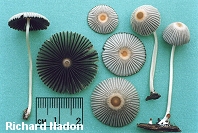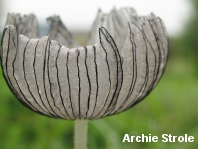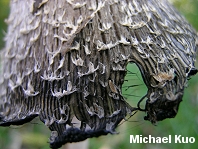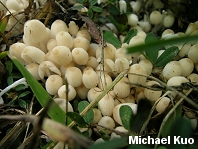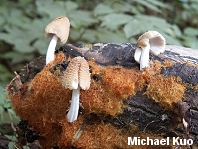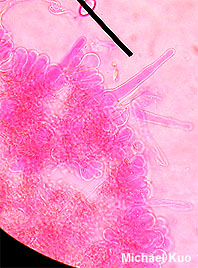References
Badalyan, S. M., K. Szafranski, P. J. Hoegger, M. Nacarro-González, A. Majcherczyk & U. Kües (2011). New Armenian wood-associated coprinoid mushrooms: Coprinopsis strossmayeri and Coprinellus aff. radians. Diversity 3: 136–254.
Bogart, F. van de (1976). The genus Coprinus in western North America, Part I: Section Coprinus. Mycotaxon 4: 233–275.
Bogart, F. van de (1979). The genus Coprinus in western North America, Part II: Section Lanatuli. Mycotaxon 8: 243–291.
Bogart, F. van de (1979). The genus Coprinus in western North America, Part III: Section Atramentarii. Mycotaxon 10: 155–174.
Brietenbach, J. & Kranzlin, F. (1995). Fungi of Switzerland: A contribution to the knowledge of the fungal flora of Switzerland. Volume 4 agarics 2nd part. Transl. Walters, V. L. & Walters, J. F. Lucern: Verlag Mykologia. 368 pp.
Chen, C. (1999). Genetic and molecular systematic study on the genus Montagnea Fr., a desert adapted Gasteromycete. Blacksburg, Virginia: Virginia Polytechnic Institute and State University thesis.
Conlon, B. H., Z. W. De Beer, H. H. De Fine Licht, D. K. Aanen & M. Poulsen (2016). Phylogenetic analyses of Podaxis specimens from Southern Africa reveal hidden diversity and new insights into associations with termites. Fungal Biology 120: 1065–1076.
Douglas, B., D. Schafer, K. Liimatainen & D. Champion (2020). Coprinopsis strossmayeri agg. new to Britain. Field Mycology 21: 5–10.
Gierczyk, B., A. Kujawa, T. Pachlewski, A. Szczepkowski & M. Wojtowski (2011). Rare species of the genus Coprinus Pers. s. lato. Acta Mycologica 46: 27–73.
Hopple, J. S. & Vilgalys, R. (1994). Phylogenetic relationships among coprinoid taxa and allies based on data from restriction site mapping of nuclear DNA. Mycologia 86: 96–107.
Hopple, J. S. & Vilgalys, R. (1999). Phylogenetic relationships in the mushroom genus Coprinus and dark-spored allies based on sequence data from the nuclear gene coding for large ribosomal subunit RNA: Divergent domains, outgroups, and monophyly. Molecular Phylogenetics and Evolution 13: 1–19.
Jorgensen, P. M., S. Ryman, W. Gams & J. A. Stalpers (2001). Proposal to conserve the name Coprinus Pers. (Basidiomycota) with a conserved type. Taxon 50: 909–910.
Keirle, M. R., D. E. Hemmes & D. E. Desjardin (2004). Agaricales of the Hawaiian Islands. 8. Agaricaceae: Coprinus and Podaxis; Psathyrellaceae: Coprinopsis, Coprinellus, and Parasola. Fungal Diversity 15: 33–124.
Ko, K. S., Y. W. Lim, Y. H. Kim & H. S. Jung (2001). Phylogeographic divergences of nuclear ITS sequences in Coprinus species sensu lato. Mycological Research 105: 1519–1526.
Lange, M. & Smith, A. H. (1953). The Coprinus ephemerus group. Mycologia 45: 747–780.
Lechner, B. E. (2015). Especies de Agaricales (Basidiomycota) halladas por primera vez en la Argentina: Agrocybe molesta, Coprinopsis romagnesiana y Gymnopus villosipes. Boletín de la Sociedad Argentina de Botánica 50: 303–307.
Luo, H., Mo, M., Huang, X., Li, X. & Zhang, K. (2004). Coprinus comatus: A basidiomycete fungus forms novel spiny structures and infects nematode. Mycologia 96: 1218–1225.
Matheny, P. B. et al. (2006). Major clades of Agaricales: A phylogenetic overview. Mycologia 98: 982–995.
McKnight, K. H. & M. Stransky (1980). Notes on Podaxis argentinum from North America. Mycologia 72: 195–199.
McKnight, K. H. (1985). The small-spored species of Podaxis. Mycologia 77: 24–35.
Michelot, D. (1992). Poisoning by Coprinus atramentarius. Natural Toxins 1: 73–80.
Money, N. P. & J. P. Ravishankar (2005). Biomechanics of stipe elongation in the basidiomycete Coprinopsis cinerea. Mycological Research 109: 627–634.
Moreno, G. & M. Heykoop (1998). Type studies in the genus Coprinus (Coprinaceae, Agaricales). Coprinus xerophilus a new record in Europe. Persoonia 17: 97–111.
Morse, E. E. (1933). A study of the genus Podaxis. Mycologia 25: 1–33.
Moser, M. (1983). Keys to Agarics and Boleti (Polyporales, Boletales, Agaricales, Russulales). Ed. Kibby, G. Transl. Plant, S. London: Roger Phillips. 535 pp.
Nagy, L. G., S. Kocsube, T. Papp & C. Vagvolgyi (2008). Phylogeny and character evolution of the coprinoid mushroom genus Parasola as inferred from LSU and ITS nrDNA sequence data. Persoonia 32: 28–37.
Nagy, L. G., D. E. Desjardin, C. Vágvölgyi, R. Kemp & T. Papp (2013). Phylogenetic analyses of Coprinopsis sections Lanatuli and Atramentarii identify multiple species within morphologically defined taxa. Mycologia 105: 112–124.
Orton, P. D. & Watling, R. (1979). British Fungus Flora. Agarics and Boleti. 2 / Coprinaceae.
Part 1: Coprinus. Her Majesty's Stationery Office, Edinburgh. 149 pp.
Patrick, W. W. Jr. (1977). Sectional nomenclature in the genus Coprinus. Mycotaxon 6: 341–355.
Patrick, W. W. Jr. (1979). Comparative morphology and taxonomic disposition of ebulbosus, quadrifidus, and variegatus in the genus Coprinus (Agaricales). Mycotaxon 10: 142–154.
Prydiuk, M. P. & M. L. Lomberg (2021). First record of Coprinopsis strossmayeri (Psathyrellaceae) in Ukraine: morphological and cultural features. Czech Mycology 73: 45–58.
Redhead, S. A. & Traquair, J. A. (1981). Coprinus Sect. Herbicolae from Canada, notes on extralimital taxa, and the taxonomic position of a low temperature basidiomycete forage crop pathogen from western Canada. Mycotaxon 13: 373–404.
Redhead, S. A., R. Vilgalys, J.-M. Moncalvo, J. Johnson & J S. Hopple, Jr. (2001) Coprinus Pers. and the disposition of Coprinus species sensu lato. Taxon 50: 203–241.
Schmit, J. P. (2002). Tradeoffs between reproduction and mycelium production in the unit–restricted decomposer Coprinus cinereus. Mycologia 94: 40–48.
Uljé, C. B. & C. Bas (1985). Coprinus hercules, spec. nov. Persoonia 12: 483–486.
Uljé, C. B. & C. Bas (1988). Studies in Coprinus—I. Subsections Auricomi and Glabri of
Coprinus section Pseudocoprinus. Persoonia 13: 433–448.
Uljé, C. B. & C. Bas (1991). Studies in Coprinus—II. Subsection Setulosi of section
Pseudocoprinus. Persoonia 14: 275–339.
Uljé, C. B. & M. E. Noordeloos (1993). Studies in Coprinus—III. Coprinus section Veliformes.
Subsection and revision of subsection Nivei emend. Persoonia 15: 257–301.
Uljé, C. B. & H. Bender (1997). Additional studies in Coprinus subsection Glabri. Persoonia
16: 373–381.
Uljé, C. B. & M. E. Noordeloos (1997). Studies in Coprinus—IV. Coprinus section Coprinus.
Subsection and revision of subsection Alachuani. Persoonia 16: 265–333.
Uljé, C. B. & M. E. Noordeloos (1999). Studies in Coprinus V—Coprinus Section Coprinus,
Revision of subsection Lanatuli Sing. Persoonia 17: 165–199.
Uljé, C. B., F. Doveri & M. E. Noordeloos (2000). Additions to Coprinus subsection
Lanatuli. Persoonia 17: 465–471.
Uljé, K. (2000). Some rare but easily recognizable inkcaps. In: Associazione Micologica Bresadola, ed. Micologia 2000. Brescia, Italy: Grafica Sette, 533–542.
Uljé, K. (2003). All about Inkcaps Web site. Retrieved from the World Wide Web: http://www.grzyby.pl/coprinus-site-Kees-Uljée/species/Coprinus.htm (see note in text above)
Uljé, K. (2003). Studies on type collections of Coprinus species. Retrieved from the World Wide Web: (URL no longer valid).
Uljé, K. (2005). Coprinus Pers. In Noordeloos, M. E., Th. W. Kuyper & E. C. Vellinga, eds. Flora Agaricina Neerlandica: Critical monographs on families of agarics and boleti occurring in the Netherlands. Volume 6. Boca Raton: Taylor & Francis. 22–111.
Vesterholt, J. (2018). Coprinopsis P. Karst. In Knudsen, H. & J. Vesterholt, eds., Funga Nordica: Agaricoid, boletoid, clavarioid, cyphelloid and gastroid genera. Copenhagen: Nordsvamp, 672–687.
This site contains no information about the edibility or toxicity of mushrooms.
Cite this page as:
Kuo, M. (2008, February). Coprinoid mushrooms: The inky caps. Retrieved from the MushroomExpert.Com Web site: http://www.mushroomexpert.com/coprinoid.html


